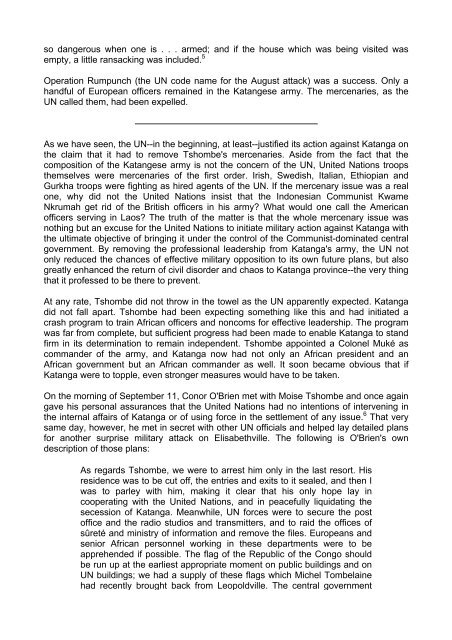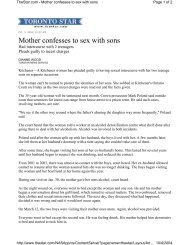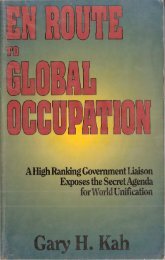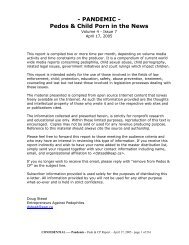G. Edward Griffin - The Fearful Master - PDF Archive
G. Edward Griffin - The Fearful Master - PDF Archive
G. Edward Griffin - The Fearful Master - PDF Archive
Create successful ePaper yourself
Turn your PDF publications into a flip-book with our unique Google optimized e-Paper software.
so dangerous when one is . . . armed; and if the house which was being visited was<br />
empty, a little ransacking was included. 5<br />
Operation Rumpunch (the UN code name for the August attack) was a success. Only a<br />
handful of European officers remained in the Katangese army. <strong>The</strong> mercenaries, as the<br />
UN called them, had been expelled.<br />
As we have seen, the UN--in the beginning, at least--justified its action against Katanga on<br />
the claim that it had to remove Tshombe's mercenaries. Aside from the fact that the<br />
composition of the Katangese army is not the concern of the UN, United Nations troops<br />
themselves were mercenaries of the first order. Irish, Swedish, Italian, Ethiopian and<br />
Gurkha troops were fighting as hired agents of the UN. If the mercenary issue was a real<br />
one, why did not the United Nations insist that the Indonesian Communist Kwame<br />
Nkrumah get rid of the British officers in his army? What would one call the American<br />
officers serving in Laos? <strong>The</strong> truth of the matter is that the whole mercenary issue was<br />
nothing but an excuse for the United Nations to initiate military action against Katanga with<br />
the ultimate objective of bringing it under the control of the Communist-dominated central<br />
government. By removing the professional leadership from Katanga's army, the UN not<br />
only reduced the chances of effective military opposition to its own future plans, but also<br />
greatly enhanced the return of civil disorder and chaos to Katanga province--the very thing<br />
that it professed to be there to prevent.<br />
At any rate, Tshombe did not throw in the towel as the UN apparently expected. Katanga<br />
did not fall apart. Tshombe had been expecting something like this and had initiated a<br />
crash program to train African officers and noncoms for effective leadership. <strong>The</strong> program<br />
was far from complete, but sufficient progress had been made to enable Katanga to stand<br />
firm in its determination to remain independent. Tshombe appointed a Colonel Muké as<br />
commander of the army, and Katanga now had not only an African president and an<br />
African government but an African commander as well. It soon became obvious that if<br />
Katanga were to topple, even stronger measures would have to be taken.<br />
On the morning of September 11, Conor O'Brien met with Moise Tshombe and once again<br />
gave his personal assurances that the United Nations had no intentions of intervening in<br />
the internal affairs of Katanga or of using force in the settlement of any issue. 6 That very<br />
same day, however, he met in secret with other UN officials and helped lay detailed plans<br />
for another surprise military attack on Elisabethville. <strong>The</strong> following is O'Brien's own<br />
description of those plans:<br />
As regards Tshombe, we were to arrest him only in the last resort. His<br />
residence was to be cut off, the entries and exits to it sealed, and then I<br />
was to parley with him, making it clear that his only hope lay in<br />
cooperating with the United Nations, and in peacefully liquidating the<br />
secession of Katanga. Meanwhile, UN forces were to secure the post<br />
office and the radio studios and transmitters, and to raid the offices of<br />
sûreté and ministry of information and remove the files. Europeans and<br />
senior African personnel working in these departments were to be<br />
apprehended if possible. <strong>The</strong> flag of the Republic of the Congo should<br />
be run up at the earliest appropriate moment on public buildings and on<br />
UN buildings; we had a supply of these flags which Michel Tombelaine<br />
had recently brought back from Leopoldville. <strong>The</strong> central government



![Robert T McQuaid [rtmq@stn.net] Sent: Friday, October 29, 2004 12 ...](https://img.yumpu.com/51070071/1/190x245/robert-t-mcquaid-rtmqstnnet-sent-friday-october-29-2004-12-.jpg?quality=85)







